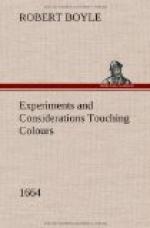[6] Album quippe & agrum, hoc quidem
asperum esse dicit, hoc vero laeve.
de Sensu & Sensib. 3. 3.
[7] Epist. 2. pag. 45.
3. But though in this passage, that very Ingenous Person has Anticipated part of what I should say; Yet I presume you will for all that expect, that I should give you a fuller Account of that Notion of Whiteness, which I have the least Exceptions to, and of the Particulars whence I deduce it, which to do, I must mention to you the following Experiments and Observations.
Whiteness then consider’d as a Quality in the Object, seems chiefly to depend upon this, That the Superficies of the Body that is call’d White, is Asperated by almost innumerable Small Surfaces, which being of an almost Specular Nature, are also so Plac’d, that some Looking this way, and some that way, they yet Reflect the Rays of Light that fall on them, not towards one another, but outwards towards the Spectators Eye. In this Rude and General account of Whiteness, it seems that besides those Qualities, which are common to Bodies of other Colours, as for instance the Minuteness and Number of the Superficial parts, the two chief things attributed to Bodies as White are made to be, First, that its Little Protuberances and Superficial parts be of somewhat a Specular Nature, that they may as little Looking-glasses each of them Reflect the Beams it receives, (or the little Picture of the Sun made on it) without otherwise considerably Altering them; whereas in most other Colours, they are wont to be much Chang’d, by being also Refracted, or by being Return’d to the Eye, mixt with Shades or otherwise. And next, that its Superficial parts be so Situated, that they Retain not the Incident Rays of Light by Reflecting them Inwards, but Send them almost all Back, so that the Outermost Corpuscles of a White Body, having their Various Little Surfaces of a Specular Nature, a Man can from no place Behold the Body, but that there will be among those Innumerable Superficieculae, that Look some one way, and some another, enough of them Obverted to his Eye, to afford like a broken Looking-glass, a confused Idaea, or Representation of Light, and make such an Impression on the Organ, as that for which Men are wont to call a Body White. But this Notion will perhaps be best Explan’d by the same Experiments and Observations, on which it is Built, And therefore I shall now advance to Them.
4. And in the first place I consider, that the Sun and other Powerfully Lucid Bodies, are not only wont to Offend, which we call to Dazle our Eyes, but that if any Colour be to be Ascrib’d to them as they are Lucid, it seems it should be Whiteness: For the Sun at Noon-day, and in Clear weather, and when his Face is less Troubled, and as it were Stained by the Steams of Sublunary Bodies, and when his Beams have much less of the Atmosphere to Traject in their Passage to our Eyes, appears of a Colour more approaching




